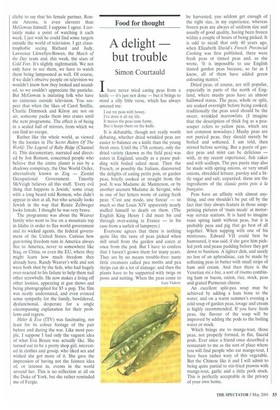Food for thought
A delight but trouble
Simon Courtauld
Ihave never tried eating peas from a knife — it's just not done — but it brings to mind a silly little verse, which has always amused me: I eat my peas with honey.
I've done it all my fife.
It makes the peas taste funny, But it keeps them on the knife.
It is debatable, though not really worth debating, whether dried wrinkled peas are easier to balance on a knife than the young fresh ones. Until the 17th century, only the dried variety (known as the field pea) was eaten in England, usually as a pease pudding with boiled salted meat. Then the French, or possibly the Italians, discovered the delights of eating petits pois, or garden peas, briefly cooked or straight from the pod. It was Madame de Maintenon, or by another account Madame de Sevigne, who in one of her letters wrote of eating fresh peas: 'C'est une mode, une fureur' — so much so that Louis XIV apparently nearly stuffed himself to death on them. (The English King Henry I did meet his end through over-eating in France — in his case from a surfeit of lampreys.)
Everyone agrees that there is nothing quite like the taste of peas picked when still small from the garden and eaten at once from the pod. But I have to confess that I haven't grown them for many years. They are by no means trouble-free: nasty little creatures called pea moths and pea thrips can do a lot of damage; and then the plants have to be supported with twigs or posts and netting. When the peas come to be harvested, you seldom get enough of the right size, in my experience, whereas frozen peas are always of uniform size and usually of good quality, having been frozen within a couple of hours of being picked. It is odd to recall that only 40 years ago, when Elizabeth David's French Provincial Cooking was first published, there were fresh peas or tinned peas and, as she wrote, 'It is impossible to use English tinned garden peas because, so far as I know, all of them have added green colouring matter.'
Dried peas, of course, are still popular, especially in parts of the north of England, where mushy peas have an almost hallowed status. The peas, whole or split, are soaked overnight before being cooked; traditionally the peas used should be the sweet, wrinkled marrowfats. (I imagine that the description of thick fog as a peasouper refers to yellow peas, which are not common nowadays.) Mushy peas are not puréed peas; they should merely be boiled and softened, I am told, then stirred before serving. But a purée of garden peas and mint can be delicious — with, in my recent experience, fish cakes and with scallops. The pea purée may also be made with spring onions, or very small onions, shredded lettuce, parsley and a little sugar and salt; unpureed, these are the ingredients of the classic petits pals a la francaise.
Peas have an affinity with almost anything, and one shouldn't be put off by the fact that they always feature in those unappetising pictures of 'main meals' at motorway service stations. It is hard to imagine roast spring lamb without peas, but it is probably peas and pig that go best of all together. When supping with one of his mistresses, Edward VII could best be humoured, it was said, if she gave him pickled pork and pease pudding before they got down to business. A lighter dish, and surely no less of an aphrodisiac, can be made by softening peas in butter with small strips of ham and cream. And then there is the Venetian risi e bisi, a sort of risotto combining ham or bacon, onion, rice, stock, peas and grated Parmesan cheese.
An excellent split-pea soup may be achieved by adding a ham bone to the water, and on a warm summer's evening a cold soup of garden peas, lovage and cream is highly recommended. If you have fresh peas, the flavour of the soup will be improved by adding the pods to the boiling water or stock.
Which brings me to mange-tout, those peas, not properly formed, in flat, flaccid pods. Ever since a friend once described a restaurant to me as the sort of place where you will find people who eat mange-tout, I have been rather wary of this vegetable. But the Chinese like it and I will admit to being quite partial to stir-fried prawns with mange-tout, garlic and a little pork stock. This is perfectly acceptable in the privacy of your own home.










































































 Previous page
Previous page